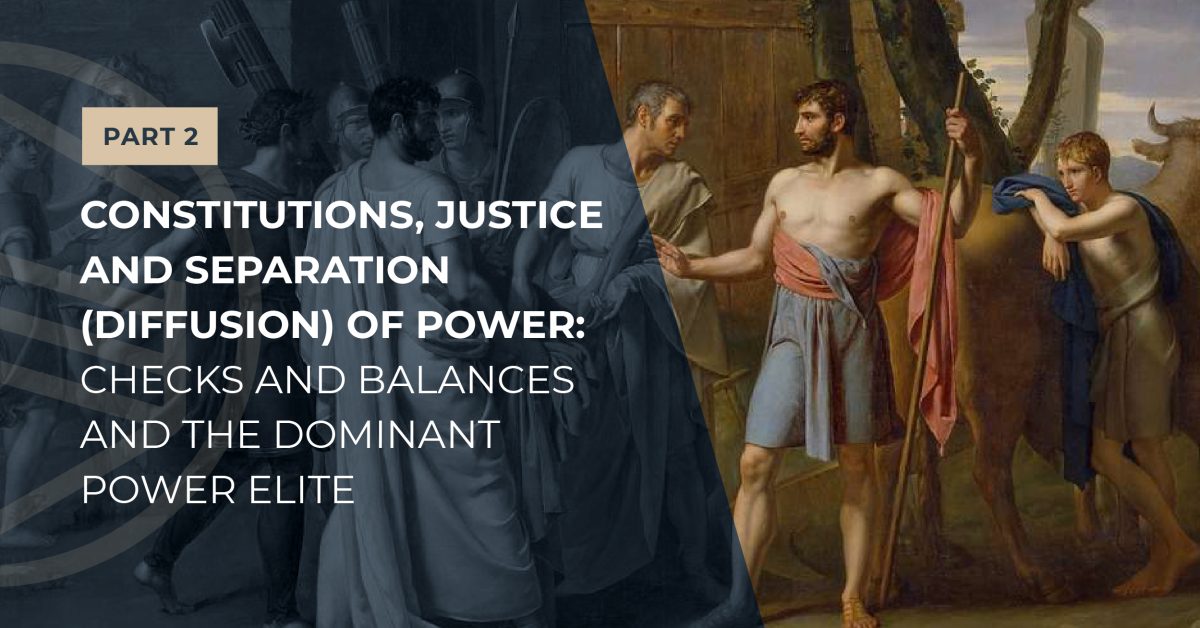
In the introductory discussion, it was explained that the distribution of power accompanied by checks and balances is an essential feature of a proper constitutional order. Power and authority should not reside in a single centre. If they do, the risk of abuse of power arises. Power and authority should be divided among multiple centres of power, and these different centres should keep each other in check. They should monitor and restrain each other – in other words, act as checks and balances against each other.
However, many people in this country are understandably very sceptical when they hear the phrase “checks and balances.” During the 1990s, assurances were repeatedly given that the Constitution would have sufficient checks and balances to keep the new government – the ANC – in check and curb its abuse of power.
There are numerous institutions that provide the machinery for checks and balances against specific state organs, and by implication, they must ensure that the executive authority composed of senior members of the ruling party works, as it were, under supervision. According to trite constitutional doctrine the following four constitutional mechanisms of control are the most important:
We will discuss all four forms of checks and balances. Indeed, we will also address others that are not explicitly mentioned in the Constitution. This will involve the civil and business communities as well as the professions. We will indicate that these non-state formations are often more significant constitutional mechanisms than those mentioned in the Constitution.
Before we proceed, however, we first need to make some clarifying observations about power and about the dominant power elite, specifically in present-day South Africa. This is of particular constitutional importance because a primary purpose of constitutions is to provide the instruments by which power is restrained – through which effective checks and balances can function. Consequently, it is essential to understand what challenges any constitution, and specifically the current South African Constitution, faces. It is in this context that the dynamics of dominant power elites come into play: what it entails and what the current South African power elite looks like. In later discussions, we will also examine divisions within a dominant power elite, as well as the decline of a dominant power elite and its succession by new ones.
Dominant Power Elite
Power is a comprehensive phenomenon encompassing political, economic, social, moral, intellectual, and similar forms of power. Therefore, it is a political (and sociological) concept in the broadest sense of the word, not just a legal or constitutional concept.
The dominant power elite entails a formal and informal coalition of institutions and individuals bound together by common ideological assumptions and objectives. It is not a single organisation; rather, it represents a leading ideological consensus within a state. With regard to South Africa, the dominant power elite primarily includes the ruling party. However, some opposition parties may also share these same ideological assumptions. Except during transitional periods when a dominant power elite is replaced by a successor, the courts, the civil service, and other state organs, indeed all institutions over which the ruling party exercises influence regarding appointments and promotions, are predominantly part of the ruling elite. Under the ANC, which has been in power for nearly thirty years, state institutions and the courts have indeed become predominantly part of the dominant power elite, and each component plays its specific role within the dominant power elite. The dominant elite also non-officially includes significant segments of mainstream media. Importantly, significant business interests are usually part of the ruling elite or are at least not readily opposed to the key principles of the ruling party. This was particularly the case in South Africa over the past three decades when big businesses mainly cooperated with the government in realizing its ideological objectives.
The Current Dominant Power Elite in South Africa
The current ruling elite under the ANC has well-defined ideological objectives that guide the actions of both the ANC itself and the rest of the ruling elite. This is expressed through the concepts of transformation and national democratic revolution. However, the term used here is not transformation, but transformationism. Transformation signifies a mere description. However, that is not what we are dealing with here; rather, we are dealing with a comprehensive ideology that drives a program aimed at a complete societal revolution. The suffix “ism” is appropriately added to transformation to clarify the ideological nature of the phenomenon at hand. Hence the term transformationism.
Transformationism is fundamentally totalitarian. Its objective is to secure ANC control over every sector of society: not only all legislative and executive centres of power but also the judiciary, the police, the military, the civil service, and all other state organs, educational institutions, professions, and indeed every other sphere of power and influence, including the economic sector. The purpose is to achieve economic equality and cultural homogeneity in the public sphere.
There are several instruments to achieve the ideological objectives of transformationism. Among the most important of these are the following:
Cadre deployment. This involves the deployment of loyal ANC supporters in every imaginable sphere of society where the ANC wants to establish and maintain control.
Representativity. This involves that every possible institution must, in terms of its management and workforce, reflect the demographic composition of the national population. The effect of this is that every institution will largely be black and under black control. Each institution will also, in terms of its composition, be a replica of all others. The effect is thus homogenization and uniformity. Ironically, this is done in the name of diversity. It is difficult to achieve this goal in a culturally and linguistically heterogeneous setup like South Africa. For example, Afrikaans institutions, due to the racial composition of Afrikaans communities, can simply not reflect the national demographic composition. Nevertheless, the dominant power elite is pushing hard to achieve this. This is why there is ongoing friction between Afrikaans institutions and the dominant power elite, as compliance with representativity necessarily entails Afrikaans communities dissolving themselves.
Representativity combined with cadre deployment. This entails the two mutually reinforcing components of an integrated strategy. It involves that all management of all representative institutions is made up of loyal ANC cadres, meaning there will be party control over a comprehensive array of uniform institutions.
This is motivated by the equality provision (Section 9) of the Constitution and is ideologically justified in the name of rectifying the consequences of apartheid. The legislative instruments used for this purpose are laws such as the Employment Equity Act (EEA), the Promotion of Equality and Elimination of All Forms of Unfair Discrimination Act (PEPUDA), and a large collection of legislation enforcing representativity.
Empowerment – property transfer and control. The ANC’s assuming power in 1994 was accompanied by the first significant so-called empowerment transactions. These took the form of transferring shares of large corporations to senior figures within the sphere of the ANC, along with initial steps to transfer corporate control to ANC leadership figures. Soon, constitutional and legislative instruments entrenched empowerment on a permanent basis. The constitutional instrument pertains to the procurement of goods and services by the state. It is provided for in Article 217 of the Constitution and legislation, specifically the Preferential Procurement Policy Framework Act (PPPFA). Accordingly, preference is given to black-owned enterprises when awarding state contracts. Furthermore, enterprises are required to meet minimum standards regarding the employment of black individuals in their workforce and management, as well as providing social services to black communities. The second general measure is the Broad-Based Black Economic Empowerment Act (BBBEEA), which lays the foundation for a comprehensive system of voluntary and mandatory property transfer (especially through shares) and control and management in the form of directorships and senior management positions for black individuals. The stated goal was that the broader black population should benefit from this, hence the qualification “broad-based.” In practice, however, only a small elite of blacks have significantly benefited from it, while the masses have been excluded. Larger numbers of black individuals have become unemployed, and the number of people dependent on social grants has exponentially increased.
The conclusion is that the dominant power elite extends across a wide front. It includes the ruling party, the public sector, in certain cases the judiciary, the military, police, the education sector, and the economic sector. It is not limited to the ruling party alone.
Dominant power elites typically tend to be comprehensive. They are usually driven and bound by a general common ideology. When dealing with a political movement like the African National Congress and other movements with distinctively leftist or rightist ideological programs, the ambition to completely reverse the political and socio-economic situation and mobilize every sphere of society for that purpose is stronger.
The phenomenon of dominant power elites is of the utmost importance for constitutional theory and practice. The power elite debilitates the effective division of power and severely compromises mechanisms of checks and balances. There could be, for instance, a threefold separation of power, and the judiciary could theoretically – in terms of structure, personnel, and functions – be independent and impartial, as trite constitutional doctrine suggests, but all ultimately forms an integral part of the dominant power elite. It shares the same ideological consensus and is committed to achieving and defending the same ideological objectives.
In such circumstances, traditional instruments of power division and checks and balances clearly fall woefully short, thus requiring entirely new thinking and actions regarding the constitution. In future discussions, this is precisely what we will explore.
SHARE THIS ARTICLE
BE THE FIRST TO:

Constitutions, Justice and separation (diffusion) of Power: An introduction
MORE ARTICLES BY PROF. KOOS MALAN

Build a state-proof future for business

Protecting Businesses and Ensuring Reliable Power Supply

Strategic Litigation
Our litigation stops state decay and harmful interference where possible, and buys time for building alternatives where necessary.
Newsletter subscribers receive breaking updates on litigation, case highlights, as well as analysis and commentary on key events affecting economic and businesses environment. You also get access to surveys and Sakeliga events.
